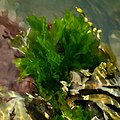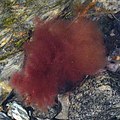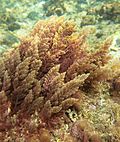Top Qs
Timeline
Chat
Perspective
Limu (algae)
Polynesian edible underwater plants From Wikipedia, the free encyclopedia
Remove ads
Limu, otherwise known as rimu, remu or ʻimu (from Proto-Austronesian *limut)[1] is a general Polynesian term for edible plants living near or underwater, such as algae.[2][3] In Hawaii, there are approximately one hundred names for kinds of limu, sixty of which can be matched with scientific names.[4] Hundreds of species of marine algae were once found in Hawaii.[5] Many limu are edible, and used in the cuisine throughout most of Polynesia.

Remove ads
Uses
Several species of limu are used as food throughout Polynesia and is typically eaten raw as accompaniment to meals, usually fish.
In Hawaii, limu was seen as a major component of the Hawaiian diet alongside fish and poi.[6] Hawaiians cultivated several varieties of seaweed for food as well as to feed fish farmed within fish ponds. As many as 75 types of limu were used for food, more than the 35 used in Japanese cuisine, which is also well known for its use of seaweed.[5] In modern times, limu is often used as a condiment, typically in raw fish dishes such as poke.[7]
Limu was used in hoʻoponopono, the ancient Hawaiian process of conflict resolution. Injured and accused parties gathered to pray, seek forgiveness and eat limu kala leaves as a symbol of reconciliation.[7][8] It is also used in traditional hula attire[9] and as medicine.[10]
Due to the shape of its foliage, the Maori also applied the name rimu to the native tree Dacrydium cupressinum.[2]
Remove ads
Types
Summarize
Perspective
Limu comes from multiple genera[6]
Cook Islands
Easter Island
French Polynesia
Hawaii
New Zealand
Niue
Samoa
Tonga
Tuvalu
Remove ads
Threats
Limu has become increasingly difficult to find because of over-picking, pollution, and urban development,[22] especially construction in watersheds. Many important kinds of limu grow best in brackish water where fresh water empties into the sea. Another threat to limu is the spread of marine alien invasive species, such as members of the genus Kappaphycus (smothering seaweed), Gracilaria salicornia (gorilla ogo), Avrainvillea amadelpha (leather mudweed), Hypnea musciformis (hook weed) and Acanthophora spicifera (prickly seaweed).[23]
See also
Further reading
- Abbott, Isabella Aiona (1992). Lā'au Hawai'i: Traditional Hawaiian Uses of Plants. Bishop Museum Press. ISBN 9780930897628.
- Abbott, Isabella Aiona; Huisman, John Marinus (2004). Marine Green and Brown Algae of the Hawaiian Islands. Bishop Museum Press. ISBN 9781581780307.
References
External links
Wikiwand - on
Seamless Wikipedia browsing. On steroids.
Remove ads






































